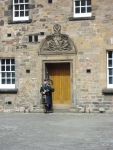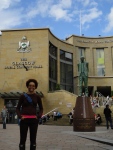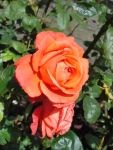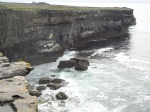I’m a big fan of animation. It’s true! Despite the passage of the years, I remain as eager to see the next Disney movie as I was when I was a child. Recently however this love for animation has taken me to the sophisticated and very interesting world of Japanese animation. This is not to say that I wasn’t aware of Japanese animation, in fact my first taste came from a translated version of Sailor Moon seen on Colombian television in 1997. Also on at the time were the first seasons of Dragonball (the old-school one, before Son Goku actually grew up…). However when I came back to Canada, these animation series were nowhere to be found on non-cable television, so I had to redirect my attention to their source material: manga. This appreciation of the combination of manga-anime remains strong to this day.
Several of the more well-known anime movies in North America come from the collaboration between Disney and Studio Ghibli, producing several movies that can be watched in their original Japanese or as a translation. However, unlike that which was usually the case historically with most Disney movies, these translation have been known to use famous actors. Although I tend to listen to the Japanese version – I quite like subtitles and I enjoy hearing the dialogue in its original language- sometimes the casting is quite fascinating.
 For example in Howl’s Moving Castle, Christian Bale is cast as the main male lead! Those of you familiar with Mr. Bale’s work know that he is not known for doing very fluffy, feel-good roles. However he does have that superb voice (which probably influenced his casting as the Dark Knight)! Furthermore the majority of the voices cast alongside him in this feature are much more mature actors: Lauren Bacall, Blythe Danner and Billy Crystal. Beyond offering an interesting story, the use of this cast tells its own story!
For example in Howl’s Moving Castle, Christian Bale is cast as the main male lead! Those of you familiar with Mr. Bale’s work know that he is not known for doing very fluffy, feel-good roles. However he does have that superb voice (which probably influenced his casting as the Dark Knight)! Furthermore the majority of the voices cast alongside him in this feature are much more mature actors: Lauren Bacall, Blythe Danner and Billy Crystal. Beyond offering an interesting story, the use of this cast tells its own story!
I would expect that the reason behind these very different casting choices is the range and depth of the stories told with the anime format!
The complex natures of the stories involved in Japanese animated movies and the manga from which they are derived, crossing  dozens of genres and aimed at a broad spectrum of audiences, is the subject of Manga: Sixty Years of Japanese Comics (2004) by Paul Gravett. This heavily illustrated, easy to read, chronology of the history of the manga genre in Japan not only gives wonderful ties-ins between the evolution of manga and Japanese culture, it also provides several samples from the different genres covered. These samples give the reader a taste of the subjects, illustrative styles and diversity of Japanese manga, ranging from manga for boys, girls, men, women, older adults with topics such as sports, romance, Japanese history, alternate history and more. If you’re unsure that there is a manga genre for you or you want to read more about its general impact, this book is for you.
dozens of genres and aimed at a broad spectrum of audiences, is the subject of Manga: Sixty Years of Japanese Comics (2004) by Paul Gravett. This heavily illustrated, easy to read, chronology of the history of the manga genre in Japan not only gives wonderful ties-ins between the evolution of manga and Japanese culture, it also provides several samples from the different genres covered. These samples give the reader a taste of the subjects, illustrative styles and diversity of Japanese manga, ranging from manga for boys, girls, men, women, older adults with topics such as sports, romance, Japanese history, alternate history and more. If you’re unsure that there is a manga genre for you or you want to read more about its general impact, this book is for you.
Among several translated Japanese anime that offer quite interesting English-language casting are:
In the more historical genre, Castle in the sky (1986) (James Van der Beek, Anna Paquin, Mark Hamill) and Steamboy (2004) (Anna Paquin, Patrick Stewart, Afred Molina). Steamboy is unique and satisfying example of steam-punk, creating an entire technology on screen based on steam technology. The Victorian-age location, with a special guest appearance of the London Great Exhibition of 1851, has a younger cast of characters. Castle in the sky is a mix between the subject of mythical and lost cities and almost steam-punk technology. Both these movies take place in a more European-type setting, easily recognizable to the Western viewer.


Spirited Away (2001) and Akira (1988), although belonging to significantly different genres, the first firmly based in Japanese folklore, with humans interacting with mythical creatures; the second based in a dystopian future, both are noticeably and visually Japanese. Furthermore, both these movies must be seen in their original Japanese, as there are no translations. These two classics of Japanese anime are not to be missed. Spirited Away, which received the Oscar for Best Animated Feature, is certainly on the less graphic or gory side than Akira. Then again, when compared to other live-action dystopian movies such as Terminator or Mad Max, it really is a matter of degree!


An important element I’d also like you to take away from this post however is the fact that this multi-audience phenomenon exists more and more in mainstream Western animated features as well. The one I am the most familiar with is one I’ve mentioned in this blog before: the DC animated universe. Some might argue that these stories are simply aimed at comic book fans and that, as they say, is that. However modern comics amateurs are not all male pre-teens and teens. A large proportion of comic book readers are in fact adults (just check out the line up at the next Free Comic Book day or the next Comic Conference in your area if you have any doubts) as well as female, and storylines in these comic books reflect the nature of their audience. Yet the movies derived from these stories often are classified and located along with kids or teen movies.
There are several movies from the DC universe repertoire that I would not show my younger nieces or nephews such as Batman: Under the Red Hood (with Bruce Greenwood, an excellent choice for the voice of Batman and a role he has taken on again for Young Justice), the first season of Justice League: Unlimited, Batman: Gotham Knight (incidentally a project entirely animated using Japanese anime) and Batman: Year One.
I realize as I write this that a trend is emerging from the previous list: Batman movies are indeed grittier than other DC animated movies, but they seem to more easily and successfully translated to the screen.
There are others of course, such as the most famous Shrek and the superhero movie the Incredibles.
And so I close this post by asking movie and story lovers to try some Japanese and Western animated features. You might be surprised and impressed by what an imagination unfettered by the limitations of the green-screen and live-action world can create!









 The tour guide then proceeded to completely shock me by declaring that the Stone of Destiny actually existed! … The theft of this famous symbol of Scottish culture has recently been immortalized on film in Stone of Destiny (2008). I had seen the trailer while watching the Brothers Bloom, or some such indie movie and had ruled out the unlikeliness of the story, yet I learned, in Scotland, that the story was true! This delightful Canadian-UK production uses several Scottish actors (e.g. Billy Boyd from Lord of the Rings and Robert Carlyle recently in Once upon a time) as well as several iconic Scottish locations to bring this unbelievable true story to life.
The tour guide then proceeded to completely shock me by declaring that the Stone of Destiny actually existed! … The theft of this famous symbol of Scottish culture has recently been immortalized on film in Stone of Destiny (2008). I had seen the trailer while watching the Brothers Bloom, or some such indie movie and had ruled out the unlikeliness of the story, yet I learned, in Scotland, that the story was true! This delightful Canadian-UK production uses several Scottish actors (e.g. Billy Boyd from Lord of the Rings and Robert Carlyle recently in Once upon a time) as well as several iconic Scottish locations to bring this unbelievable true story to life.







 really be experienced in the Old World (Europe and Asia). This sexually explicit, and highly descriptive mystery follows Rilke, a promiscuous auctioneer who tries to unearth the truth of some disturbing photographs found among an enigmatic deceased belongings. Familiar locations such as Kelvin Way, Argyle Street, Byrnes Road, and the Necropolis steep the story narrative with an unsettling sense of reality.
really be experienced in the Old World (Europe and Asia). This sexually explicit, and highly descriptive mystery follows Rilke, a promiscuous auctioneer who tries to unearth the truth of some disturbing photographs found among an enigmatic deceased belongings. Familiar locations such as Kelvin Way, Argyle Street, Byrnes Road, and the Necropolis steep the story narrative with an unsettling sense of reality.




 The arguments behind my choice in reading SS Atlantic: The White Star Line’s First Disaster at Sea (2009) by Greg Cochkanoff and Bob Chaulk, are two-fold. Firstly, the book is Canadian; Canadiana is something I try to stay in touch with as much as possible, at least in terms of history. Secondly, it deals with what I like to call the “forgotten history”. Yes, the Titanic sank in 1912, yes Céline Dion sang the theme for the movie, and yes the story has been told over and over, but look (!) others ships from the famous White Star Line have sunk, with passengers on board, trying to reach the promise land! Let’s hear a little about them.
The arguments behind my choice in reading SS Atlantic: The White Star Line’s First Disaster at Sea (2009) by Greg Cochkanoff and Bob Chaulk, are two-fold. Firstly, the book is Canadian; Canadiana is something I try to stay in touch with as much as possible, at least in terms of history. Secondly, it deals with what I like to call the “forgotten history”. Yes, the Titanic sank in 1912, yes Céline Dion sang the theme for the movie, and yes the story has been told over and over, but look (!) others ships from the famous White Star Line have sunk, with passengers on board, trying to reach the promise land! Let’s hear a little about them. North Atlantic really can be and The Reef (1998) by Nora Roberts. Although The Reef takes place in the Caribbean, the discovery of priceless treasures and personal effects with a thousand possible stories, is the main reason behind modern marine archaeology, a goal which compelled the author Greg Cochkanoff to explore The SS Atlantic for as long and as consistently as he did. This passion for discovery is one of the main storylines developed in The Reef.
North Atlantic really can be and The Reef (1998) by Nora Roberts. Although The Reef takes place in the Caribbean, the discovery of priceless treasures and personal effects with a thousand possible stories, is the main reason behind modern marine archaeology, a goal which compelled the author Greg Cochkanoff to explore The SS Atlantic for as long and as consistently as he did. This passion for discovery is one of the main storylines developed in The Reef. On our last day in Belfast, we (appropriately) ferried across the Irish Sea to Scotland aboard Stena Line’s Stena Superfast (VII or VIII, I don’t remember). This 10+ deck, luxurious, superferry had more than any person would need for a 2-hour journey, including wi-fi, cabins (if you REALLY want your privacy), snack-bars, a Nordic Spa (!), free movies and a really cool children’s area including 3 Xboxes which can be played without remotes! All in all, it’s nice to see that Belfast retains its reputation to creating luxurious naval vessels, even into the 21st century. And it’s certainly a step up, in terms of security, from sea travellers from the 19th and early 20th centuries. Although I do remember an incident recently about a cruise ship out of Italy, running aground in the Mediterranean…
On our last day in Belfast, we (appropriately) ferried across the Irish Sea to Scotland aboard Stena Line’s Stena Superfast (VII or VIII, I don’t remember). This 10+ deck, luxurious, superferry had more than any person would need for a 2-hour journey, including wi-fi, cabins (if you REALLY want your privacy), snack-bars, a Nordic Spa (!), free movies and a really cool children’s area including 3 Xboxes which can be played without remotes! All in all, it’s nice to see that Belfast retains its reputation to creating luxurious naval vessels, even into the 21st century. And it’s certainly a step up, in terms of security, from sea travellers from the 19th and early 20th centuries. Although I do remember an incident recently about a cruise ship out of Italy, running aground in the Mediterranean… For example in Howl’s Moving Castle, Christian Bale is cast as the main male lead! Those of you familiar with Mr. Bale’s work know that he is not known for doing very fluffy, feel-good roles. However he does have that superb voice (which probably influenced his casting as the Dark Knight)! Furthermore the majority of the voices cast alongside him in this feature are much more mature actors: Lauren Bacall, Blythe Danner and Billy Crystal. Beyond offering an interesting story, the use of this cast tells its own story!
For example in Howl’s Moving Castle, Christian Bale is cast as the main male lead! Those of you familiar with Mr. Bale’s work know that he is not known for doing very fluffy, feel-good roles. However he does have that superb voice (which probably influenced his casting as the Dark Knight)! Furthermore the majority of the voices cast alongside him in this feature are much more mature actors: Lauren Bacall, Blythe Danner and Billy Crystal. Beyond offering an interesting story, the use of this cast tells its own story! dozens of genres and aimed at a broad spectrum of audiences, is the subject of Manga: Sixty Years of Japanese Comics (2004) by Paul Gravett. This heavily illustrated, easy to read, chronology of the history of the manga genre in Japan not only gives wonderful ties-ins between the evolution of manga and Japanese culture, it also provides several samples from the different genres covered. These samples give the reader a taste of the subjects, illustrative styles and diversity of Japanese manga, ranging from manga for boys, girls, men, women, older adults with topics such as sports, romance, Japanese history, alternate history and more. If you’re unsure that there is a manga genre for you or you want to read more about its general impact, this book is for you.
dozens of genres and aimed at a broad spectrum of audiences, is the subject of Manga: Sixty Years of Japanese Comics (2004) by Paul Gravett. This heavily illustrated, easy to read, chronology of the history of the manga genre in Japan not only gives wonderful ties-ins between the evolution of manga and Japanese culture, it also provides several samples from the different genres covered. These samples give the reader a taste of the subjects, illustrative styles and diversity of Japanese manga, ranging from manga for boys, girls, men, women, older adults with topics such as sports, romance, Japanese history, alternate history and more. If you’re unsure that there is a manga genre for you or you want to read more about its general impact, this book is for you.









 Handel’s name. Indeed Handel’s famous Messiah was not first played London, but rather in Dublin, a fact explored in Handel’s Messiah: A Celebration by Richard Luckett (1992), published for the 250th anniversary of its first performance.
Handel’s name. Indeed Handel’s famous Messiah was not first played London, but rather in Dublin, a fact explored in Handel’s Messiah: A Celebration by Richard Luckett (1992), published for the 250th anniversary of its first performance. As I already own some music from the Irish tenors, singing about several Dublin locations (St. Stephen’s green and Dublin itself), I decided to diversify a little and purchased a 2-disc album by Clannad (2010), whose lead singer Máire Ni Bhraonáin is sister to the famous Enya. Clannad 2 and Dúlamán were released in 1974 and 1976, but as with all excellent music, especially music for which I don’t understand the words, the tunes are ageless. Indeed most of the songs on this double record are sung in Gaelic. The packaging includes a rather complete booklet with liner notes (and y’all know how much I like those!). The overall tone of the albums is easy listening, best enjoyed at the end of a stressful day or during a rainy afternoon with a good cup of tea (much like the stereotypical weather of Ireland), alongside such singers as Billie Holliday and Eva Cassidy.
As I already own some music from the Irish tenors, singing about several Dublin locations (St. Stephen’s green and Dublin itself), I decided to diversify a little and purchased a 2-disc album by Clannad (2010), whose lead singer Máire Ni Bhraonáin is sister to the famous Enya. Clannad 2 and Dúlamán were released in 1974 and 1976, but as with all excellent music, especially music for which I don’t understand the words, the tunes are ageless. Indeed most of the songs on this double record are sung in Gaelic. The packaging includes a rather complete booklet with liner notes (and y’all know how much I like those!). The overall tone of the albums is easy listening, best enjoyed at the end of a stressful day or during a rainy afternoon with a good cup of tea (much like the stereotypical weather of Ireland), alongside such singers as Billie Holliday and Eva Cassidy.





 The Country Cooking of Ireland is a great recipe book. Firstly, it’s illustrated! Secondly it also uses and discusses certain culinary elements that can only be found in Ireland, thus adding to the argument of going over there and experiencing the food first hand. Thirdly, this book offers historical explanations to certain aspects and ingredients of Irish cuisine. Fourthly, this book explicitly tries to veer away from the bland stereotype that has followed Irish cooking for years. And finally, the recipes in here are quite good.
The Country Cooking of Ireland is a great recipe book. Firstly, it’s illustrated! Secondly it also uses and discusses certain culinary elements that can only be found in Ireland, thus adding to the argument of going over there and experiencing the food first hand. Thirdly, this book offers historical explanations to certain aspects and ingredients of Irish cuisine. Fourthly, this book explicitly tries to veer away from the bland stereotype that has followed Irish cooking for years. And finally, the recipes in here are quite good. Claude-Michel Schönberg and Alain Boublil. Les Misérables is based on the novel by the same name by Victor Hugo. The story has been sung in English, in French, in Japanese and several other languages and has appeared on the big screen in action, non-musical versions, one of which I have seen with Liam Neeson and Geoffrey Rush (1998), but never before has it been adapted directly from the musical as it will be this year.
Claude-Michel Schönberg and Alain Boublil. Les Misérables is based on the novel by the same name by Victor Hugo. The story has been sung in English, in French, in Japanese and several other languages and has appeared on the big screen in action, non-musical versions, one of which I have seen with Liam Neeson and Geoffrey Rush (1998), but never before has it been adapted directly from the musical as it will be this year. Secondly, the concept of this musical is also quite intriguing to me because this extremely popular English-language piece was actually translated, or rather adapted, from the original French. This is not the same as translating a movie, a book, or a single piece of music. We’re talking here of 3 hours of emotionally captivating song and dance which much preserve the same kind of emotional impact no matter what the language. As someone who grew up speaking English in Quebec, I am aware of the many intricacies of language that can be a challenge on many different levels. I was pleasantly surprised to learn, while reading The musical world of Boublil & Schönberg : the creators of Les Misérables, Miss Saigon, Martin Guerre, and The pirate queen(2006), that Alain Boublil, the librettist, is involved in all adaptations of his work in each language that it’s adapted to.
Secondly, the concept of this musical is also quite intriguing to me because this extremely popular English-language piece was actually translated, or rather adapted, from the original French. This is not the same as translating a movie, a book, or a single piece of music. We’re talking here of 3 hours of emotionally captivating song and dance which much preserve the same kind of emotional impact no matter what the language. As someone who grew up speaking English in Quebec, I am aware of the many intricacies of language that can be a challenge on many different levels. I was pleasantly surprised to learn, while reading The musical world of Boublil & Schönberg : the creators of Les Misérables, Miss Saigon, Martin Guerre, and The pirate queen(2006), that Alain Boublil, the librettist, is involved in all adaptations of his work in each language that it’s adapted to.
 mainly with the Great Famine (1845-1850) has made the Irish population a significant representative of the world population, as members of our families and communities around the English-speaking world. This tale draws on historical plots from the great migration boats of the late 19th and early 20th century to tell a three-part romance story which spans from Ireland to Iceland to New York city.
mainly with the Great Famine (1845-1850) has made the Irish population a significant representative of the world population, as members of our families and communities around the English-speaking world. This tale draws on historical plots from the great migration boats of the late 19th and early 20th century to tell a three-part romance story which spans from Ireland to Iceland to New York city. Her Irish trilogy takes mostly place in south-east of Ireland, the county of Waterford. Focusing on the more memorable aspects of Irish society: pubs, music and myths, these three stories are simply a fun read. Just like the cottage belonging to Kate Winslet’s character in The Holiday(2006), these three stories are cozy, intimate and picturesque with just the right touch of love at first sight, rediscovering old loves and love grown over time.
Her Irish trilogy takes mostly place in south-east of Ireland, the county of Waterford. Focusing on the more memorable aspects of Irish society: pubs, music and myths, these three stories are simply a fun read. Just like the cottage belonging to Kate Winslet’s character in The Holiday(2006), these three stories are cozy, intimate and picturesque with just the right touch of love at first sight, rediscovering old loves and love grown over time.



 For those who want more insight about the actions and locations mentioned in Lorraine Heath’s novel they might want to turn their attention to Death or Glory: the legacy of the Crimean War by Robert B. Edgerton. The secondary purpose of this book is to serve as a comparison between this conflict and the American civil war. Edgerton takes the time to present the points of view, as much as is possible, of all the armies, of which there were many, who were involved in the Crimean War. All in all a very informative read.
For those who want more insight about the actions and locations mentioned in Lorraine Heath’s novel they might want to turn their attention to Death or Glory: the legacy of the Crimean War by Robert B. Edgerton. The secondary purpose of this book is to serve as a comparison between this conflict and the American civil war. Edgerton takes the time to present the points of view, as much as is possible, of all the armies, of which there were many, who were involved in the Crimean War. All in all a very informative read. ok to pursue the reading experience because of its setting. Just as the British armies were composed of Irish, Scottish and other soldiers from the British isles, the Turkish army was composed of several members of the very diverse Ottoman Empire, of which Albania, the one of the main locations of The Lion’s Daughter, used to belong . As such, it offers a wonderful opportunity to explore this little used location in the context of a historical romance. Loretta Chase, whose blog you can find here
ok to pursue the reading experience because of its setting. Just as the British armies were composed of Irish, Scottish and other soldiers from the British isles, the Turkish army was composed of several members of the very diverse Ottoman Empire, of which Albania, the one of the main locations of The Lion’s Daughter, used to belong . As such, it offers a wonderful opportunity to explore this little used location in the context of a historical romance. Loretta Chase, whose blog you can find here 